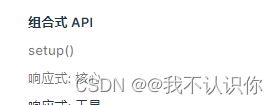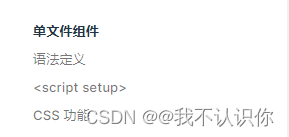前言
vue2中props属性的使用是比较统一的基本就一种方式,但是vue3中其实方式是比较多的,因此就打算梳理一下。
会按照选项式和组合式进行梳理,包括属性的定义、取值以及属性的监听。
应该是叫单文件组件和组合式API,不知道vue官方是根据什么区分的。

单文件组件
定义
这里大体上分为两大类进行说明,这两大类都需要使用
defineProps
来进行定义
非ts语法
const props =defineProps({// 基础类型检查// (给出 `null` 和 `undefined` 值则会跳过任何类型检查)propA: Number,// 多种可能的类型propB:[String, Number],// 必传,且为 String 类型propC:{type: String,required:true},// Number 类型的默认值propD:{type: Number,default:100},// 对象类型的默认值propE:{type: Object,// 对象或数组的默认值// 必须从一个工厂函数返回。// 该函数接收组件所接收到的原始 prop 作为参数。default(rawProps){return{message:'hello'}}},// 自定义类型校验函数propF:{validator(value){// The value must match one of these stringsreturn['success','warning','danger'].includes(value)}},// 函数类型的默认值propG:{type: Function,// 不像对象或数组的默认,这不是一个工厂函数。这会是一个用来作为默认值的函数default(){return'Default function'}}})
这种方式还是比较简单的,基本和vue2没有太大的区别。
ts语法
interfaceganttChartItem{// 宽度width: number,// 颜色color: string
}interfaceProps{// idid:string
// 宽度width: number,// 高度
height?: number,// 是否初始化
init?: boolean,// 子项
list?: Array<ganttChartItem>,// 是否显示描述
desc?:string
// 描述颜色
descColor?:string
}const props =withDefaults(defineProps<Props>(),{// 高度默认20height:20,// 默认初始化init:true,// 子项默认为空list:()=>[],// 是否显示描述desc:'',// 描述颜色descColor:''});
特殊点:
- 泛型,可以通过定义
interface接口来规范props的属性的格式。不像vue2中定义一个对象类型的属性,这个对象中可以有各种各样的子属性。 ?:表示可选属性,:表示必填属性- 定义默认属性值时需要使用
withDefaults
取值
取值时可以当成一个普通的对象,例如:
props.desc
监听
watch(()=> props.visible,(val)=>{
open.value = val;
console.log(val);});
demo
<a-b v-model:visible="show"/>//ab.vue<template><div class="container"><el-dialog v-model="open" title="Tips" width="30%"><span>This is a message</span></el-dialog></div></template><script setup lang="ts">import{ watch, ref }from'vue';const props =defineProps({visible:{type: Boolean,default:false}});const open =ref(false);watch(()=> props.visible,(val)=>{
open.value = val;
console.log(val);});</script>
这里有个问题,虽然弹窗绑定的值可以直接是属性,但是好像不推荐这样使用
组合式
感觉setup语法糖模式用的更多一点(可能是我们公司用的比较多)。好久没这样用了,差点忘记怎么写了😀
定义
这个没什么说的,跟vue2一样
props:{visible:{type: Boolean,default:false}},
使用
使用时需要通过setup函数传参的方式来取值。
setup(props){return{
props
};}
监听
watch(()=> props.visible,(val)=>{
open.value = val;
console.log(val);});
demo
<template><div><el-dialog v-model="open" title="Tips" width="30%"><span>This is a message</span></el-dialog></div></template><script lang="ts">import{ defineComponent, watch, ref }from'vue';exportdefaultdefineComponent({props:{visible:{type: Boolean,default:false}},setup(props){const open =ref(false);watch(()=> props.visible,(val)=>{
open.value = val;
console.log(val);});return{
open
};}});</script>
补充
其实没必要非要用props属性,props属性应该在该用的时候用。
可以看一下我的这篇文章:vue3:使用ref和emit来减少props的使用
版权归原作者 无知的小菜鸡 所有, 如有侵权,请联系我们删除。